Powder coating is a durable, long-lasting finish, but sometimes you need to change the color or repair damage. Painting over it directly might seem impossible, but with the right preparation, it's achievable and can yield excellent results. This comprehensive guide walks you through the entire process, ensuring a professional-looking finish.
Why Painting Over Powder Coat is Tricky (and How to Overcome It)
Powder coating's resilience is its biggest challenge when repainting. Its tough, baked-on finish resists adhesion, meaning new paint might peel or chip easily. To successfully paint over powder coat, you need to thoroughly compromise this inherent resistance. This involves a multi-step process focused on cleaning, etching, and priming.
Step-by-Step Guide to Painting Over Powder Coated Metal
This detailed process ensures a lasting, attractive finish on your powder-coated metal project:
1. Preparation: The Key to Success
This phase is critical. Skipping steps will almost certainly lead to paint failure.
-
Cleaning: Thoroughly clean the surface with a degreaser and a stiff brush or abrasive pad. Remove all grease, dirt, dust, and loose particles. A pressure washer can be helpful for larger items, but ensure you don't damage the underlying metal. Allow the surface to dry completely.
-
Scuffing: Use sandpaper (80-120 grit) or a sanding block to lightly scuff the powder coat's surface. The goal isn't to remove the entire coating but to create a slightly rough texture that enhances adhesion. Focus on creating a consistent matte finish across the entire piece, avoiding over-sanding in any one area.
-
De-glossing: After scuffing, wipe the surface clean again. Use a suitable de-glossing agent or a solvent-based cleaner to remove any remaining residue and further dull the surface. This step aids paint adhesion.
-
Washing and Drying: Clean the surface once more with clean water and a lint-free cloth to remove any dust or sanding debris. Thoroughly dry the surface before proceeding.
2. Etching: Creating a Mechanical Bond
Etching creates microscopic imperfections that help the primer bond mechanically to the powder coat.
-
Chemical Etching: Consider using a commercial metal etching primer. This provides both an etch and a primer layer in one step, simplifying the process. Follow the manufacturer's instructions carefully.
-
Mechanical Etching: For a more aggressive approach, you can use a chemical etchant specifically designed for metal. Follow the product instructions meticulously, paying close attention to safety precautions, as these chemicals can be harsh.
3. Priming: The Foundation for a Lasting Finish
Priming is crucial for a durable paint job.
-
Primer Selection: Choose a high-quality, adhesion-promoting primer formulated for metal. Look for primers specifically designed for use over existing finishes. Apply the primer evenly in thin coats, allowing each coat to dry completely before applying the next. Two coats are generally recommended.
-
Drying Time: Allow the primer to dry completely according to the manufacturer’s instructions. This usually involves several hours. Insufficient drying can lead to peeling and cracking.
4. Painting: Achieving a Professional Finish
-
Paint Selection: Select a high-quality paint suitable for metal and compatible with your primer. Consider the type of finish you want (e.g., gloss, matte, satin).
-
Application: Apply the paint in thin, even coats using a high-quality brush, roller, or spray gun. Multiple thin coats are better than one thick coat, preventing runs and drips and ensuring even coverage.
-
Drying Time: Allow each coat to dry completely before applying the next coat. This drying time will depend on the type of paint used and environmental conditions.
5. Finishing Touches (Optional)
- Clear Coat: For added protection and durability, consider applying a clear coat once the paint is fully dry. This provides an extra layer of defense against scratches and UV damage.
Troubleshooting Common Problems
-
Peeling Paint: This usually indicates insufficient preparation. Ensure you thoroughly cleaned, scuffed, etched, and primed the surface.
-
Uneven Finish: This might be due to uneven paint application or insufficient drying time between coats.
By following these steps meticulously, you can successfully paint over powder-coated metal, transforming its appearance and extending its lifespan. Remember, patience and thorough preparation are key to achieving a professional-looking and long-lasting result.

